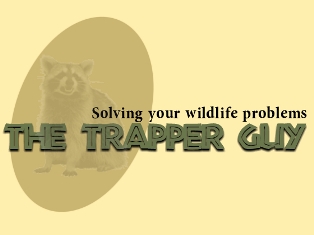
Call
now to solve your nuisance
wildlife problem!
727-710-0373
Serving
Madeira Beach, FL with humane
critter removal 24 hrs a day*
and 7 days a week
Click
here for a free estimate
It wasn't long
ago that Madeira beach was covered
in sea oats and pine trees.
Many of our wild
friends either get pushed out
or become 'urbanized'.
Peoples attics
seem like a cozy nesting place.
Trash cans and pet food are easy
meals and swimming pools are convenient
toilets and bathing spots.
As harmless as
their intentions may be, some
wildlife can
be extremely destructive
to your property. We specialize in Madeira Beach rat control and raccoon trapping.
The Trapper Guy
will come out and humanely
remove the live animal
from your property and if possible,
relocate it.
I will fix the damage caused and
make preventative measures so
they won't return.
With proper wildlife
control we can co-exist
with our wild neighbors.
*
24
hour services are for emergencies
only. Live animal in a living
area where safety of the occupants
is in question is considered an
emergency.
|
Mad
Beach Wildlife News
Dead
fish are from blast, not Red Tide
City officials say an underwater construction
explosion caused the deaths of a few
snook.
By LINDSAY MICHEL
Published August 16, 2006
-----------------------------------------------
MADEIRA BEACH - Beachgoers
who recently noticed dead fish washed
up near John's Pass need not worry that
Red Tide is here.
Construction at the
John's Pass bridge that required an
underwater blast Aug. 3 is the likely
culprit, according to city and wildlife
preservation officials.
"It's not from
Red Tide," said Mike Maxemow, community
service director for the city of Madeira
Beach.
The underwater blasts,
which took down the bridge's south bascule,
were delivered by Flatiron Constructors
Inc., and were monitored by various
wildlife conservation workers. Another
blast is planned for Aug. 24.
Construction companies
consult many wildlife agencies before
they go forth with the blasts, said
Bruce Hasbrouk, vice president and environmental
services director of Faller, Davis &
Associates Inc.
Hasbrouk, who is also
a marine biologist and an environmental
consultant for the Department of Transportation,
has worked on blasting projects for
25 years and said he has never experienced
any serious wildlife damage after a
construction explosion.
"We have a lot
of agencies we have to coordinate with
prior to any underwater explosions,
and they review our plan and provide
comments," he said.
Officials from the Fish
and Wildlife Conservation Commission,
who are conducting research on grouper,
snapper and snook collected 23 dead
snook and two injured snook after the
blast, Hasbrouk said.
"So a lot of the
fish did go to research," he said.
"Fortunately it was just those
fish and not the protected species."
When there is underwater
blasting, officials observing from helicopters
and bridges ensure that no protected
species like manatees, sea turtles or
porpoises are in the danger zone, which
was a 2,000-foot radius, on Aug. 3.
Before and after the
blast, officials walked for an hour
along the beaches to see that no harm
would be done to the animals. However,
the sound of the explosion can sometimes
kill smaller fish, which is what "could
have caused a fish kill like that,"
said Dana Hooker, chief operating officer
at the Clearwater Marine Aquarium.
The same precautions
will be used on Aug. 24 when the last
part of the underwater bascule will
be demolished, Hasbrouk said.
So far this year, the
Fish and Wildlife Research Institute
has found high concentrations of Red
Tide from Lido Key in Sarasota County
to the Naples Pier in Collier County.
Lindsay Michel can be
reached at lmichel@sptimes.com or at
727 893-8333.
|